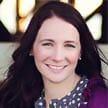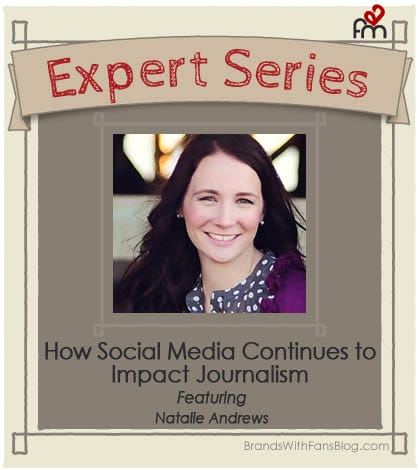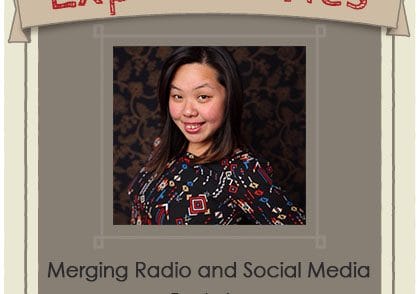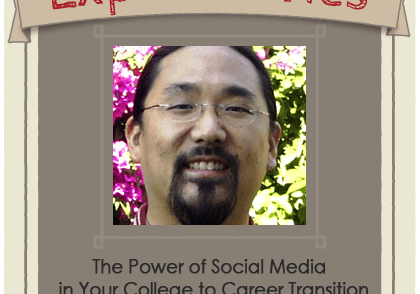If there is one person who understands how to successfully mix good journalism and social media, its Natalie Andrews. Natalie is the former social media news director at KSL in Salt Lake City, Utah, and is currently a social media editor for The Wall Street Journal D.C. Bureau. She started at KSL in 2012 in a newly created social news director position and it was a big job to say the least. Not long before Natalie started at KSL, it combined its TV, radio, newspaper and two big websites into one newsroom. She admits there was a lot of digital and social content flow, but “any time you’re in a social media position, it’s nice to have more content than you know what to do with.” The cross platform development was content overload for someone coming in to create a social strategy, but Natalie effectively navigated through the noise of the newsroom and created a winning social strategy that includes two Interactive Emmys for TV.
Recently, Natalie accepted a social media editor position with The Wall Street Journal D.C. Bureau and her and her cute little black pug Dahlia moved to the East Coast. She just helped launch the Capital Journal to revamp the political coverage for The Wall Street Journal with an increased digital focus. The launch included a newsletter and a redesigned Twitter feed among other things to communicate, push and interact with readers. Her expertise and experience will no doubt be vital to The Wall Street Journal team and we are excited for her to share her expertise with us as our June featured expert.
BWF: KSL scored two interactive Emmys while you were there, how was that accomplished?
Our social strategy was to get people engaged with expert interviews that we then showcased along with brainteasers.
NA: For two years in a row, Rocky Mountain Emmy awarded our team the Interactive Emmy, which was great. Our first Interactive Emmy came from a story we did called Brain Test. You hear people talk about pregnancy brain or old-timer’s brain, so we decided to put it to the test. Our social strategy was to get people engaged with expert interviews that we then showcased along with brainteasers. This all happened during our 10 p.m. shows and we would have our viewers respond via social. Our engagement was off the charts.
BWF: What specific strategy did you use to combine social and news with Brain Test?
You have to be willing to go out of the box a little bit.
NA: In a nutshell, we used social to push to the TV shows, then TV to push back to social. I think that’s the most effective way with news, or any type of promotion like this. I always refer to social media as a science, but it’s also the Wild West. We look at data to see how it’s all working, but we also need to try new things and think outside the box a little bit. No one wants to see the same thing over and over again.
BWF: What does your social media program look like?
The content and plan of the day drastically change, sometimes by the hour.
NA: We specifically mimic our news coverage. We use social to drive traffic to our content and communicate with our readers. It’s based on the content of the day. If there’s a primary election that night, our coverage is going to be very election-focused. If there’s a hearing on net neutrality, we’re going to be very focused on the FCC and what they are doing. The content and plan of the day drastically change, sometimes by the hour.
BWF: What does a day in the life of a social editor look like?
I start by looking at what’s trending.
NA: I have a routine. I get in and immediately start looking for what’s trending, what people are talking about, how we performed the day before and how we’re performing now. Then, in our morning meeting, I try to alert anybody to, “Hey, this is what was said or this politician said this or this happened over here that we need to pay attention to” to kind of gauge the day. And then, we go from there.
BWF: How do you build the online community at The Wall Street Journal D.C. Bureau?
We’re joining the conversation.
NA: In the basic sense of building a community, I think it’s important to make sure we have all our i’s dotted, i.e. with links to social media on our site, a strategy of distribution, and an understanding of who your audience is. We do some identifying, too, which is following a hashtag that people are using to talk about a topic and saying, “Okay, so this is a hot race and it’s in this state so let’s see what people are talking about over here.” So, we’re joining that conversation. This helps us further our reach by giving specifically valuable content to people who may not be following us.
BWF: What would you say has been challenging in combining social media with news?
NA: You’re always wondering what’s coming next; what’s the breaking news going to be? Hacking is also a very real issue. There’s an awful lot of security around journalism. Security along with accuracy is a daily challenge.
BWF: When it comes to journalistic integrity, how do you carry over traditional journalism standards to social media?
How can we say this in 140 characters accurately and fitting to the story?
NA: When you’re speaking as the voice of a trusted news organization, you want to be accurate. All journalism standard rules apply in social media just like they would on TV and any other platform where journalism is practiced. You don’t want to say anything on social media that you wouldn’t also say on air, in print, etcetera. Keeping those standards and being the standard bearer is vital to mixing news and social media. It’s a daily struggle of saying, “How can we say this in 140 characters while remaining accurate and still fitting the integrity of the story?”
BWF: What engagement is working the best with your audience right now?
You need to remember you’re a part of a community and not an all seeing, God-like voice.
NA: I think it’s fun to ask people questions. If there’s a big debate on Capitol Hill, we ask our followers, “Well, what do you think? How would you vote? How would you weigh in on this issue?” and then we’ll retweet them. People like to be retweeted by an account with a mass following. I think it’s important to remember we’re part of a community and not an all seeing, God-like voice.
“You need to remember you’re a part of a community and not an all seeing, God-like voice.” ~@nataliewsj http://t.co/KNXKh9DUx8
— Fandom Marketing (@FandomMarketing) June 18, 2014
BWF: How do you measure your success?
We haven’t found the perfect formula yet, but we’re getting there.
NA: Overall, to make sure our audience is growing and our content is resonating, we use a combination of tools. We specifically look at Twitter analytics for the number of people clicking on links we’re tweeting out. We also look at Omniture for the data coming into the site. We look at how many people are finding our stories via social media and what sites specifically are driving the most traffic. We also watch for certain blogs that might be continually picking up our stories. These are all ways we can see where most of our traffic is coming from. Then we can keep an eye out and watch what they’re posting. We haven’t found the perfect formula yet, but we’re getting there.
BWF: How big is your social team?
I work with multiple editors from all around the world.
NA: We have a team of social media editors that work for The Wall Street Journal, so I’m definitely not alone in that regard, but they’re based all around the world. If I email them at midnight, there’s someone watching for the main WSJ feeds. My focus is politics, D.C. Politics, the Fed, the Econ, bankruptcy; we do a lot out of D.C. I implement strategy and work with training our D.C. bureau on social media so we’re all using it.
BWF: Do you ever use user generated content in stories?
People tweeted us and we made a little story out of it.
NA: Yes, just a few weeks ago we had the National Spelling Bee winners in the newsroom, so we tweeted out, “Hey! Does anybody have any questions for these guys?” and people tweeted us back and we made a little story out of it. I also recently did a story on George H. W. Bush jumping out of a helicopter for his 90th birthday. A lot of politicians were wishing him a happy birthday, so we put a little story together using those tweets.
BWF: As far as changes in digital marketing, what has impacted the news industry and what surprised you the most about it?
Most people receive news through their mobile device.
NA: Last month marked the 20th anniversary for WSJ.com website. It’s kind of interesting if you think about how we were using the Internet 20 years ago. I can’t speak for the whole digital strategy, but most of my news consumption has changed over the past few years, especially with mobile. It’s a big deal. If you look at breaking news now, most people receive it through their mobile device and that definitely changes news. It requires us to be faster without losing accuracy and journalistic integrity. In breaking news situations, people are going crazy and they’re tweeting up a storm. It’s so important to be accurate and not add to the rumor mill. I’d rather be the second or third person tweeting out the breaking news update, because I know we have it confirmed in-house and we’re ready to go with it, than racing to be the first one.
BWF: In what ways have you noticed mobile changing the news is distributed?
It’s life changing.
NA: Mobile impacts how we need to write stories. It’s life changing. Most people use their phones as their alarm clock and once their awake; they’ll look at their newsfeed of choice. It’s really important that our content be visible on all devices as well as social channels. BWF: How do you stay on top of social media trends?
You want to keep an eye on what people are doing and combine it with your own innovation.
NA: Having a good network of people you can talk to and ask questions. Seeing what other people are trying is also helpful, and it’s a great idea to bookmark any great ideas you find. You want to keep an eye on what people are doing and combine it with your own innovation. Staying updated on social media capacity tools is also important.
BWF: What’s one big lesson you’ve learned that you wish you could teach others?
Don’t spread misinformation.
NA: Accuracy. Don’t spread misinformation. And always give credit where credit is due. For example, if you didn’t take the photo, don’t tweet it out like you took it.
“Don’t spread misinformation. And always give credit where credit is due.” ~@nataliewsj http://t.co/KNXKh9DUx8 — Fandom Marketing (@FandomMarketing) June 18, 2014
Meet Expert: Natalie Andrews
 Natalie is the social media editor for The Wall Street Journal in Washington DC. She love news and believes the ability to tell stories that raise awareness, make a difference, and inspire is a power that should be treasured. Follow her, and the latest news on Twitter @nataliewsj.
Natalie is the social media editor for The Wall Street Journal in Washington DC. She love news and believes the ability to tell stories that raise awareness, make a difference, and inspire is a power that should be treasured. Follow her, and the latest news on Twitter @nataliewsj.
Want to be featured next? Fandom is looking for social marketing rock stars to share their stories, case studies, tips and expertise. Check out our blogging guidelines and contact us or tweet us @FandomMarketing today.





1 Comment
Never thought of some of these things, and I can see now how the two overlap. Great post.